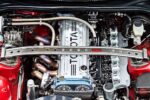Chevy Duramax Engine: A Brief Overview
History and Development
The Chevy Duramax engine series has been a significant player in the diesel engine market since its inception in 2001. Developed in collaboration with Isuzu, the Duramax was designed to meet the growing demand for powerful, efficient, and reliable diesel engines in heavy-duty trucks. Initially introduced in the Chevrolet Silverado and GMC Sierra, the Duramax quickly gained a reputation for its robust performance and durability, making it a preferred choice for both commercial and personal use.
Over the years, the Duramax engine has undergone several iterations, with advancements in technology and engineering aimed at improving performance, fuel efficiency, and emissions. The introduction of the LLY, LBZ, LMM, LML, and the latest L5P variants showcased a continuous evolution that addressed the needs of truck owners and the stringent regulations imposed on diesel engines. Each generation brought enhancements in horsepower, torque, and towing capacity, solidifying the Duramax’s position as a formidable contender in the diesel market.
However, despite its accolades, the Duramax engine is not without its issues. As with any complex machinery, various problems have emerged over the years, ranging from minor inconveniences to significant failures. These issues have raised concerns among owners and potential buyers, prompting discussions about the reliability and longevity of the Duramax engine. Understanding these problems is crucial for anyone considering a Duramax-powered vehicle, as it can impact maintenance costs, safety, and overall satisfaction.
In this article, we will delve into the common problems associated with the Chevy Duramax engine, providing a straightforward analysis of what owners can expect and how to address these challenges effectively.
Common Issues with the Chevy Duramax Engine
The Chevy Duramax engine, while known for its strength and reliability, has its share of problems that can affect performance and longevity. Understanding these issues is essential for current and prospective owners. Below are some of the most common problems associated with the Duramax engine, along with their symptoms and potential consequences.
1. Fuel Injector Failures
Fuel injectors are critical components in the Duramax engine, responsible for delivering the right amount of fuel to the combustion chamber. Over time, these injectors can fail due to wear and tear or contamination.
Symptoms:
– Rough idling
– Decreased fuel efficiency
– Increased exhaust smoke
Consequences:
– Poor engine performance
– Potential engine damage if not addressed promptly
2. EGR Cooler Issues
The Exhaust Gas Recirculation (EGR) cooler is designed to reduce emissions by recirculating exhaust gases back into the engine. However, it can become clogged or fail, leading to overheating and other complications.
Symptoms:
– Overheating engine
– Loss of power
– Coolant leaks
Consequences:
– Engine damage due to overheating
– Increased emissions leading to potential legal issues
3. Head Gasket Failures
Head gaskets are essential for maintaining pressure and preventing coolant leaks. In the Duramax engine, head gasket failures can occur, particularly in high-mileage vehicles.
Symptoms:
– White smoke from the exhaust
– Coolant in the oil
– Overheating engine
Consequences:
– Severe engine damage
– Expensive repairs
4. Turbocharger Problems
The turbocharger plays a vital role in enhancing engine performance by forcing more air into the combustion chamber. Issues with the turbocharger can lead to significant power loss.
Symptoms:
– Whistling or grinding noises
– Decreased acceleration
– Check engine light activation
Consequences:
– Reduced engine efficiency
– Potential turbo replacement costs
5. Transmission Issues
While not directly related to the engine itself, transmission problems can affect the overall performance of the Duramax-powered vehicles. Common issues include slipping gears and overheating.
Symptoms:
– Delayed shifting
– Unusual noises during operation
– Fluid leaks
Consequences:
– Reduced towing capacity
– Expensive transmission repairs
Symptoms and Consequences Table
| Problem | Symptoms | Consequences |
|---|---|---|
| Fuel Injector Failures | Rough idling, decreased fuel efficiency, increased exhaust smoke | Poor engine performance, potential engine damage |
| EGR Cooler Issues | Overheating engine, loss of power, coolant leaks | Engine damage, increased emissions |
| Head Gasket Failures | White smoke, coolant in oil, overheating | Severe engine damage, expensive repairs |
| Turbocharger Problems | Whistling noises, decreased acceleration, check engine light | Reduced engine efficiency, potential turbo replacement |
| Transmission Issues | Delayed shifting, unusual noises, fluid leaks | Reduced towing capacity, expensive repairs |
Conclusion
The Chevy Duramax engine, while powerful and capable, is not without its flaws. Understanding these common problems can help owners take proactive measures to maintain their vehicles and avoid costly repairs. Regular maintenance and timely interventions are crucial to ensuring the longevity and performance of the Duramax engine.




0 Comments